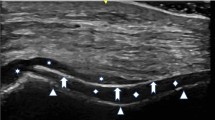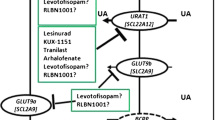Abstract
Gout is currently the most common form of inflammatory arthritis in men. The overall incidence of gout has increased rapidly in the past 20 years. Clinicians in all fields are likely to experience a patient with acute gout in their career. Uncontrolled gout and hyperuricemia can lead to joint destruction and significant morbidity. Fortunately, these diseases can be readily treated and long-term sequelae can be prevented. Recent advances in understanding the role of the innate immune system in acute gout have provided new treatment options. This article addresses the epidemiology, inflammatory pathophysiology, pain management techniques (including recent advances), and treatment of the underlying disease itself.
Similar content being viewed by others
References and Recommended Reading
Howe S, Edwards NL: Controlling hyperuricemia and gout in cardiac transplant recipients. J Musculoskelet Med 1995, 12:15–24.
Agudelo C, Wise C: Crystal-associated arthritis in the elderly. Rheum Dis Clin North Am 2000, 26:527–546.
Lawrence RC, Helmick CG, Arnett FC, et al.: Estimates of the prevalence of arthritis and selected musculoskeletal disorders in the United States. Arthritis Rheum 1998, 41:778–799.
Choi HK, Ford ES: Prevalence of the metabolic syndrome in individuals with hyperuricemia. Am J Med 2007, 120:442–447.
Choi HK, Churan G: Soft drinks, fructose consumption, and the risk of gout in men: prospective cohort study. Brit Med J 2008, 336:309–312.
Popp JD, Bidgood WD, Edwards NL: Magnetic resonance imaging of tophaceous gout in the hands and wrists. Semin Arthritis Rheum 1996, 25:282–289.
Perez-Ruiz F, Martin I, Canteli B: Ultrasonographic measurement of tophi as an outcome measure for chronic gout. J Rheumatol 2007, 34:1888–1893.
Jaramillo M, Godbout M, Naccache PH, et al.: Signaling events involved in macrophage chemokine expression in response to monosodium urate crystals. J Biol Chem 2004, 279:52797–52805.
Liu-Bryan R, Scott P, Sydlaske A, et al.: Innate immunity conferred by toll-like receptors 2 and 4 and myeloid differentiation factor 88 expression is pivotal to monosodium urate monohydrate crystal-induced inflammation. Arthritis Rheum 2005, 52:2936–2946.
Maccagno A, Di Giorgio E, Romanowicz A: Effectiveness of etodolac (’Lodine’) compared with naproxen in patients with acute gout. Curr Med Res Opin 1991, 12:423–429.
Shrestha M, Morgan DL, Moreden JM, et al.: Randomized double-blind comparison of the analgesic efficacy of intramuscular ketorolac and oral indomethacin in the treatment of acute gouty arthritis. Ann Emerg Med 1995, 26:682–686.
Willburger RE, Mysler E, Derbot J, et al.: Lumiracoxib 400 mg once daily is comparable to indomethacin 50 mg three times daily for the treatment of acute flares of gout. Rheumatol (Oxford) 2007, 46:1126–1132.
Navarra S, Rubin BR, Yu Q, et al.: Association of baseline disease and patient characteristics with response to etoricoxib and indomethacin for acute gout. Curr Med Res Opin 2007, 23:1685–1691.
Schlesinger N: Management of acute and chronic gouty arthritis. Drugs 2004, 64:2399–2416.
Wallace SL: Colchicine analogs in the treatment of acute gout. Arthritis Rheum 1959, 2:389–394.
Ahern MJ, Reid C, Gordon TP: Does colchicine work? Results of the first controlled study in gout. Aust N Z J Med 1987, 17:301–304.
Zhang W, Doherty M, Bardin T, et al.: EULAR evidence based recommendations for gout. Part II: management. Report of a task force of the EULAR Study Committee for Interventional Clinical Studies Including Therapeutics (ESCISIT). Ann Rheum Dis 2006, 65:1312–1324.
Kuncl RW, Duncan G, Watson D, et al.: Colchicine myopathy and neuropathy. N Eng J Med 1987, 316:1562–1568.
Siegal LB, Alloway JA, Nashel DJ: Comparison of adrenocorticotropic hormone and triamcinolone acetate in the treatment of acute gouty arthritis. J Rheumatol 1994, 21:1325–1337.
Getting SJ, Christian HC, Flower RJ, Perretti M: Activation of melanocortin type 3 receptor as a molecular mechanism for adrenocorticotropic hormone efficacy in gouty arthritis. Arthritis Rheum 2002, 46:2765–2775.
Hoffman HM, Firestein GS: Anakinra for the treatment of neonatal-onset multisystem inflammatory diseases. Nat Clin Pract Rheumatol 2006, 2:646–647.
So A, De Smedt T, Revaz S, Tschopp J: A pilot study of IL-1 inhibition by anakinra in acute gout. Arthritis Res Ther 2007, 9:R28.
Borstad GC, Bryant LR, Abel MP, et al.: Colchicine for prophylaxis of acute flares when initiating allopurinol for chronic gouty arthritis. J Rheumatol 2004, 31:2429–2439.
Hahn P, Edwards NL: Management of hyperuricemia. In Arthritis and Allied Conditions, 15th edn. Edited by Koopman WJ. Baltimore: Williams and Wilkins; 2004.
Scott JT: Comparison of allopurinol and probenecid. Ann Rheum Dis 1966, 25:623–626.
Hande KR, Noone RM, Stone WJ: Severe allopurinol toxicity. Description and guidelines for prevention in patients with renal insufficiency. Am J Med 1984, 76:47–56.
Perez-Ruiz FCM, Calabozo M, Fernandez-Lopez MJ, et al.: Treatment of chronic gout in patients with renal function impairment. An open, randomized, actively controlled study. J Clin Rheumatol 1999; 5:49–55.
Vazquez-Mellado J, Morales EM, Pacheco-Tena C, et al.: Relationship between adverse events associated with allopurinol and renal function in patients with gout. Ann Rheum Dis, 2001, 60:981–983.
The Gout & Uric Acid Education Society. Available at http://www.gouteducation.org. Accessed June 2008.
Author information
Authors and Affiliations
Corresponding author
Rights and permissions
About this article
Cite this article
Kirby, B.S., McTigue, J.C. & Edwards, N.L. Pain management in gout. Current Science Inc 12, 418–422 (2008). https://doi.org/10.1007/s11916-008-0071-9
Published:
Issue Date:
DOI: https://doi.org/10.1007/s11916-008-0071-9




